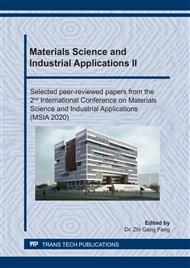p.35
p.41
p.47
p.53
p.61
p.67
p.73
p.79
p.84
Thermal Behavior Analysis of Melamine Modified Urea-Formaldehyde Resin with Different Molar Ratios
Abstract:
In this study, Thermogravimetry (TG) were used to analyze thermal degradation properties of two kinds of low-molar ratio of the melamine-modified urea-formaldehyde resin (MUF). The MUF was calculated using Kissinger equation and Flynn-Wall-Ozawa equation Resin pyrolysis activation energy. The results showed that the curing time of low mole was longer than that of MUF resin (muf-b), the content of free formaldehyde was lower, and the formaldehyde emission and wet bonding strength of plywood were reduced by 65.79% and 21.90%, respectively. TG test showed that the pyrolysis process of MUF resins with different molar ratios can be divided into three stages: dehydration, rapid pyrolysis and carbonization. At the same heating rate, the weight loss rate, peak conversion rate and carbon residue of the high molar ratio MUF resin (MUF-a) in the fast pyrolysis stage are larger than those of the MUF-b resin. The MUF-a resin pyrolysis activation energy is 166.76 kJ/mol, and the MUF-b resin pyrolysis activation energy is 95.30 kJ/mol. High molar ratio resin has higher pyrolysis activation energy and better thermal stability.
Info:
Periodical:
Pages:
61-66
Citation:
Online since:
July 2020
Authors:
Price:
Сopyright:
© 2020 Trans Tech Publications Ltd. All Rights Reserved
Share:
Citation:


